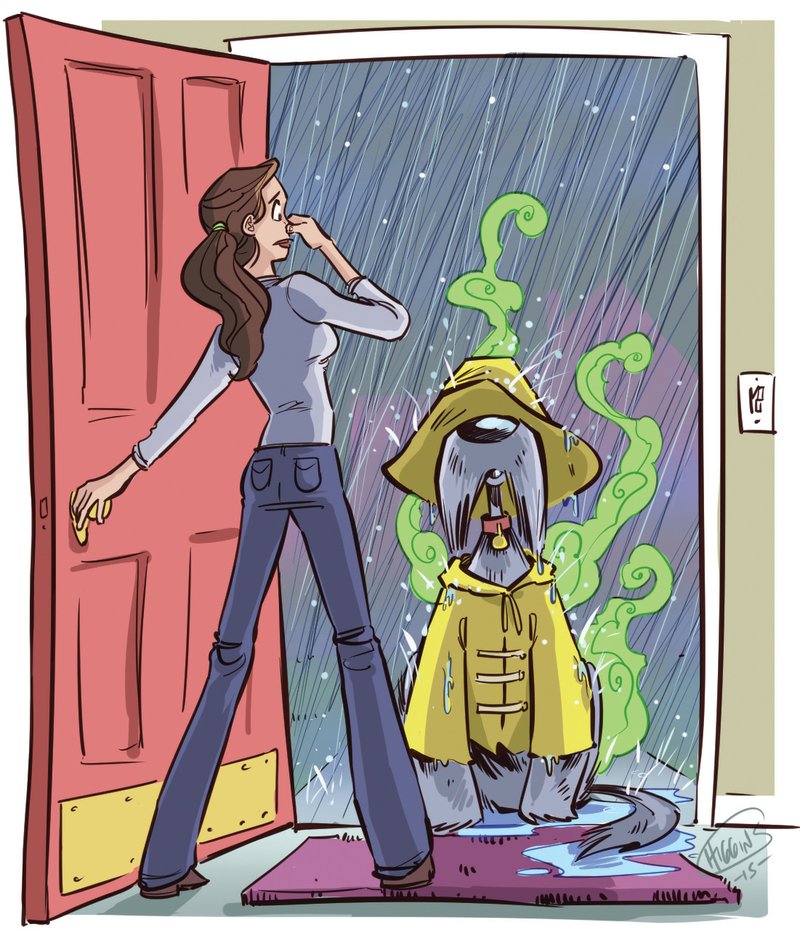I love my dog, but hate how he smells when he’s been outside in the rain for a few minutes. What causes the odor and what can I do about it?
The origin of that unpleasant musty odor is a buildup of bacteria on the skin, a condition that usually results from a dog’s fur not being dried from the skin out each time he’s gotten wet. When dogs get damp or even fully wet, owners typically towel-dry them and let the air do the rest. Therein lies the smelliness, according to DogChannel.com.
Depending on the length and thickness of a dog’s coat, it can take hours to dry completely. During that time, bacteria multiply in the fertile dampness. The next time the dog gets wet, the bacteria rise up and make their presence known to our sense of smell. We’re talking about normal “eau de wet dog,” not the more pungent odor that’s caused by a skin condition or infection. A typical wet-dog smell will lessen or even seem to go away once the dog is dry, while the odor that signals a health problem will be noticeable all the time. If your dog stinks ’round the clock, seven days a week, it’s time for a visit to the veterinarian to find out the cause.
In the case of a healthy wet dog, the evaporation of water from skin releases the malodorous bacteria molecules into the air, explains thenakedscientists.com thenakedscientists.com, a website of the University of Cambridge, England. The more bacteria present on the skin, the more molecules of scent exist to be released for our smelling displeasure.
There are two steps to dealing with this dilemma of dampness: Bathe the dog at least once a week with an odor-reducing doggy shampoo, then dry the dog with with a blow-dryer on the cool setting. The key is reducing the bacteria and making sure the dog is completely dry. That’s not to say that you have to bathe your dog every time he goes out to tinkle in a sprinkle of rain. Just be sure to dry him completely when he returns to the house.
Reducing the amount of water that accumulates on a dog’s skin when he goes outside in wet weather might also help reduce the odor or, at the least, make drying the pup easier. There are plenty of stylish and serviceable doggy raincoats on the market. To get the most scent reduction for your buck, make sure you buy one that’s 100 percent waterproof and covers the dog from neck to tail.
Most dog coats cover a pooch’s back, which makes sense given that’s where the rain lands, but few wrap around the stomach and chest. But if you’ve got a dog that likes the tall grass or stands low to the ground, you’ll still have to deal with a wet belly. The waterproof Muddy Mutts Underbelly Dog Coat is designed to be worn alone or with a raincoat. When a dog’s wearing the underbelly garment without an “overcoat,” it appears as if the owner might have put a regular coat upside down (now that’s an idea) on the dog. The Underbelly Dog Coat covers the stomach and chest, and has long sleeves for the front legs. Adjustable straps fasten over the dog’s back ($70-$90).
Now that the dog’s belly and back are protected, there’s still the issue of wet feet. Dog booties have been around awhile, but Pawz Dog Boots has come out with a rubber version to keep paws dry. They’re available in tiny through extra-large sizes and in a rainbow of colors ($14-$20).
Stay dry, smell sweet.
Do you have a question about pets? We’ll get you an answer from an authority. Send your question to Rhonda Owen, Arkansas Democrat-Gazette, P.O. Box 2221, Little Rock, Ark. 72203 or e-mail
askcreature@att.net
